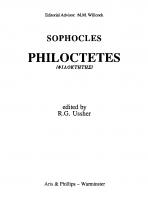Sophocles: The Philoctetes [2 ed.]
236 111 19MB
English Pages 333 Year 1898
Recommend Papers
![Sophocles: The Philoctetes [2 ed.]](https://ebin.pub/img/200x200/sophocles-the-philoctetes-2nbsped.jpg)
- Author / Uploaded
- R.C. Jebb
File loading please wait...
Citation preview
SOPHOCLES T H E PLAYS A N D F R A G M E N T S .
PART IV. THE PHILOCTETES.
SonDon: C. J. CLAY AND SONS, CAMBRIDGE UNIVERSITY PRESS WAREHOUSE, AVE MARIA LANE. ffilaggofo: 263, ARGYLE STREET.
ILttpjtfl: F. A. BROCKHAUS. gnrft: THE MACMILLAN COMPANY E. SEYMOUR HALE.
SOPHOCLES THE
PLAYS A N D F R A G M E N T S
WITH CRITICAL NOTES, COMMENTARY, AND TRANSLATION IN ENGLISH PROSE,
BY
R. C. J E B B , LITT.D., REGIUS PROFESSOR OF GREEK AND FELLOW OF TRINITY COLLEGE IN THE UNIVERSITY OF CAMBRIDGE : HON. LL.D. EDINBURGH, HARVARD AND DUBLIN; HON. DOCT. PHILOS., BOLOGNA.
PART IV. THE PHILOCTETES. SECOND EDITION.
EDITED FOR THE SYNDICS OF THE UNIVERSITY
CAMBRIDGE: AT THE UNIVERSITY PRESS. 1898 [All Rights reserved^
PRESS.
u* Edition 1890. ind Edition 1898
CONTENTS. INTRODUCTION . . ...... . . page vii § i. The home of Philoctetes. §§ 2, 3. The legend in epic poetry. § 4. Characteristics of the epic version. § 5. The story as a theme for drama. § 6. The three great dramatists. § 7. The Philoctetes of Aeschylus. § 8. The Philoctetes of Euripides. § 9. Sophocles —his originality. § 10. Analysis of the play. § 11. General scope of the treatment. § 12. The oracle. § 13. Episode of the merchant. § 14. The Chorus. § 15. Odysseus. § 16. Topography. §17. Other literature of the subject. Greek plays. § 18. Attius. Euphorion. § 19. Fe"nelon's Te"le"maque. — Lessing. — French dramas. § 20. The legend in Art. § 21. The scene of the sacrifice. § 22. Chryse. § 23. Date of the play. Supposed political reference. § 24. Diction. § 25. Versification. MANUSCRIPTS, EDITIONS, ETC. . . . . . . . §§ i, 2. The Laurentian and other MSS. § 3. Scholia. § 4. Interpolations. § 5. Emendations. § 6. Editions, etc.
xliii
METRICAL ANALYSIS .
.
xlvi
ANCIENT ARGUMENTS TO THE PLAY ; DRAMATIS PERSONAE ; STRUCTURE .........
3
TEXT
6
.
.
.
......
.
.
.
.
.....
y
APPENDIX .
.
.
.
.
.
.
.
.
.
.
2 2 9
INDICES
.
.
.
.
.
.
.
.
.
.
2 5 5
.
INTRODUCTION. § i. ON the eastern coast of Greece, just north of Thermo- The home pylae, lies a region which in ancient times was called Malis,' the °octeteS. sheep-land.' This was the country of Philoctetes,—the home to which, in the play of Sophocles, his thoughts are constantly turning1. It will be well to form some idea of its chief features and associations. Pindus, the spine of northern Greece, terminates at the south in Typhrestus, a great pyramidal height from which two mountain-ranges branch out towards the eastern sea. One of these is Othrys, which skirts the southern border of Thessaly; the other, south of it, is Oeta, which, like Malis, takes its name from its pastures. The deep and broad depression between them is the fertile valley of the Spercheius (the ' hurrying' or ' vehement') —which rises at the foot of Typhrestus, and flows into the Malian Gulf. A few miles from the sea, the valley opens. While Othrys continues its eastward direction, Oeta recedes southward, and then, with a sudden bend to the south-east, 1 The Homeric Catalogue includes this district in Phthia, the realm of Achilles (//. 2. 682). It assigns Philoctetes to a more northerly part of Thessaly,—viz., the narrow and mountainous strip of coast, N. and E. of the Pagasaean Gulf, which was known in historical times as Magnesia. His four towns were Methone, Thaumacia, Meliboea and Olizon. (//. 2. 716 f.) This agrees with the fact that Poeas, the father of Philoctetes, was called the son of Thauinacus, and was numbered among the Argonauts who sailed from lolcus (Apollod. r. 9. 16). In its original form, the story of Poeas and his son must have belonged, like that of Jason, to the legends of the Minyae who dwelt on the eastern coasts of Thessaly. Cp. Anthol. append. 61 (vol. II. p. 754 ed. Jacobs): TO^WV 'Hpa/cX^ous rafdyv, HoiavTiov vl6v, ijSe ^I\OKT^T^V yi) Mwudj /target. It was when the myth became interwoven with the apotheosis of Heracles that the home of Poeas was transferred to the country around Trachis.
viii
INTRODUCTION.
sweeps down upon Thermopylae, where the fir-clad and snowy
summit of Callidromus rises above the pass. Precipitous cliffs are thrown forward from this part of the Oetaean range, forming an irregular crescent round the southern and western sides of the plain. These cliffs were called of old 'the Trachinian Rocks.' Trachis, the ' city of the crags/ stood on a rocky spur beneath them, a little north of the point where they are cleft by the magnificent gorge of the Asopus,—that steep ravine by which Hydarnes led his Persians up through the mountain oak-woods, on the night before he surprised Leonidas. Between the Asopus and the Spercheius are the narrow channels of two lesser streams, anciently known as the Melas and the Dyras1. The name Malis denoted this whole seaboard plain, with the heights around it, from the lower spurs of Othrys on the north to those of Oeta on the south and west.. Just opposite the entrance of the Gulf, the bold north-west promontory of Euboea, once called Cape Cenaeum, runs out towards the mainland. There was a peculiar fitness in the phrase of Sophocles, when he described this district, with its varied scenery, as c the haunt of Malian Nymphs2,' 1 The Dyras was said to have first started from the ground in order to relieve the fiery pangs of Heracles (Her. 7.198). In a vase-painting noticed below (n. on v. 728, p. 121, ist col.), the Nymph who seeks to quench the pyre probably symbolises this stream. The ancient mouth of the Spercheius was some miles N. w. of Thermopylae; the present mouths are a little E.N.E. of it, and the line of the coast has been considerably advanced, so that there is no longer a narrow pass. The Asopus, Melas and Dyras formerly had separate courses to the sea. They are now mere affluents of the Spercheius,—the Melas and Dyras uniting before they reach it. 2 v. 725 at>\av MaXiddwp vvnQav.
INTRODUCTION.
ix
those beings of the forest and the river, of the hills and the sea. It was in this region that legend placed the last deeds of Heracles, and his death, or rather his passage from earth to Olympus. After taking Oechalia in Euboea, he was sacrificing on Cape Cenaeum when the fatal robe did its work. He was carried to his home at Trachis; and then he commanded that he should be borne to the top of Mount Oeta, sacred to Zeus, and burnt alive. He was obeyed ; as the flames arose on the mountain, they were answered from heaven by the blaze of lightning and the roll of thunder; and by that sign his companions knew that the spirit of the great warrior had been welcomed to the home of his immortal father. Somewhere in the wilds of those lonely summits tradition showed the sacred spot known as ' the Pyre'; and once, at least, in later days a Roman Consul, turning aside from a victorious progress, went up to visit the solemn place where the most Roman of Greek heroes had received the supreme reward of fortitude1. § 2. Heracles had constrained his son Hyllus to aid in pre- Thelegen paring the funeral-pile, but could not prevail upon him to kindle it. That office was performed, at his urgent prayer, by the youthful Philoctetes, son of Poeas, king of Malis2. In token of gratitude, Heracles bequeathed to Philoctetes the bow and arrows which he himself had received from Apollo. In the myths relating to the Trojan war a most important part belonged to the man who had thus inherited the invincible weapons. Homer, indeed, does not say much about him; but the Iliad contains only an episode in the tenth year of the war: the part played by Philoctetes came before and after that moment. The allusion in the Second Book of the Iliad is, 1
Manius Acilius Glabrio, after taking Heracleia near Trachis, in the war with Antiochus (191 B.C.). Livy 36. 30: ipse Oetam ascendit, Herculique sacrificium fecit in eo loco quern Pyram, quod ibi mortale corpus eius dei sit crematum, appellant. Cp. Silius Italicus 6. 452: Vixdum clara dies summa lustrabat in Oeta | Herculei monimenta rogi.—The name Pyra seems to have been usually associated with a height about eight miles w. N.w. of Trachis. 2 With regard to the other version, according to which Poeas was the kindler, see on v. 802.
x
INTR OD UCTION.
however, significant; it glances backwards and forwards. He is there mentioned as a skilful archer, who had sailed from Greece in command of seven ships, but had been left behind in Lemnos, wounded by the bite of a deadly water-snake. And then the poet adds that the Greeks at Troy will soon have cause to bethink them of Philoctetes1. In the Odyssey he is named only twice; in one place, as having been the best bowman at Troy; in another, as one of those heroes who came safely home2. But his adventures were fully told in other epics. The events preceding the action of the Iliad were contained in the Cypria> an epic whose reputed author, Stasinus of Cyprus, lived early in the eighth century B.C. That poem described how Philoctetes was bitten by the snake,—while the Greeks, on their way to Troy, were at Tenedos,—and was abandoned in Lemnos. His later fortunes were narrated in the Little Iliad, ascribed to Lesches of Mitylene (circa 700 B.C.), and in the Iliupersis, or' Sack of Troy,' by Arctinus of Miletus (c. 776 B.C.). The contents of these lost works are known chiefly from the prose summaries of the grammarian Proclus (140 A.D.), as partly preserved by Photius in his Bibliotheca. The following is an outline of the story in its epic form.' § 3. When the Greeks under Agamemnon were about to sail against Troy, it became known that an oracle had commanded them to offer sacrifice, in the course of their voyage across the Aegean, at the altar of a deity named Chryse. All the accounts placed this altar somewhere in the north-east of the Archipelago. The prevalent version assigned it to a small island which, like the deity herself, was called Chryse, and lay close to the eastern shore of Lemnos. Jason, it was said, had sacrificed at this altar when he was leading the Argonauts in quest of the golden fleece. Heracles had paid it a like homage when he was levying war against Laomedon. 1
//. 2. 721 ff.: dXX' 6 /j£i> £v vijfftp
netTo Kpartp'
&\yea
Arj/JUHj) ev iiya.8eri, S9i fuv \lirov vies 'A.x, 6'r' dtrf\nre Tl









